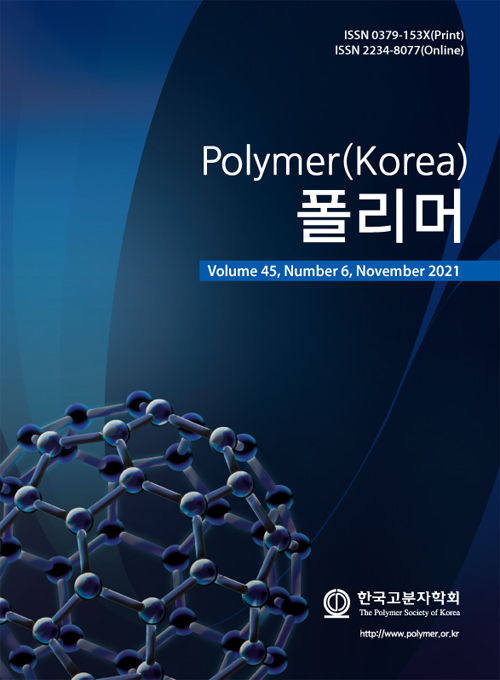- 3-D Modeling of Epoxy Reaction Molding Process for GIS Spacer
R&D Center, Dongwoo Electric Corp., 34, Oseongseo-ro, Anjung-eup, Pyeongtaek-si, Gyeonggi-do 17928, Korea
*Division of Chemical Engineering, Dankook University, 152 Jukjeon-ro, Suji-gu, Yongin-si, Gyeonggi-do 16890, Korea- GIS 스페이서에 대한 에폭시 반응 성형 공정의 3-D 모델링
동우전기㈜, *단국대학교 화학공학과
Reproduction, stored in a retrieval system, or transmitted in any form of any part of this publication is permitted only by written permission from the Polymer Society of Korea.
By introducing cure kinetics and chemorheology for auto pressure gelation (APG) epoxy resins, curing behavior and flow analysis and molding simulation studies were conducted. Using the heat evolved and degree of cure obtained from the dynamic differential scanning calorimetry (DSC) test, various parameters of the Kamal-Sourour model, a representative empirical expression of curing kinetics, were obtained and calculated, and the results were in good agreement with the experimental values. In addition, the change in rheological properties during the curing process was investigated through a dynamic oscillatory rheometer test, and these results were applied to the cross Castro-Macosko model and matched well with the experimental values. The parameters of cure kinetics and chemorheology were input into the mold flow software with other physical properties, and simulations were performed on a three-phase spacer. While changing the mold temperature gradient, the flow pattern, temperature profile, and degree of cure distribution inside the product were observed during molding. As a result, it was found that there is a risk of clogging the mold gate at some sets of mold temperature, and improvement directions can be suggested to solve this problem. Through this series of the research process, it is thought that it will be of great help in improving the quality of the molded product and thus process improvement.
Auto pressure gelation(APG)용 에폭시 수지를 대상으로 경화속도론과 화학 유변학을 도입함으로써 경화거동과 유동해석 및 이에 따른 성형 모사 연구를 수행하였다. 동적 시차주사열량법(DSC) 시험을 이용하여 얻은 발열량, 경화도 등을 이용하여 대표적인 경화속도론 경험식인 Kamal-Sourour model의 여러 인자들을 구해 계산한 결과 실험값과 잘 부합하였다. 또한 동적 회전형 레오미터 시험을 통해 경화과정에서 유변물성의 변화를 조사하였고 이들 결과를 cross Castro-Macosko model에 적용한 결과 실험값에 잘 부합하였다. 이상에서 구한 경화속도론과 화학유변학의 여러 인자 들과 기타 물리적 특성값을 몰드플로우 소프트웨어에 입력하고 삼상 스페이서를 대상으로 하여 시뮬레이션을 수행하였다. 금형 온도구배를 변화시켜가면서 제품 성형 과정에서 제품 내부의 유동과 온도 및 경화도의 변화 및 분포 등을 관찰하였다. 이 결과 일부의 설정온도에서 금형 입구가 막힐 우려가 있다는 것을 찾을 수 있었고 이를 해결하기 위한 개선방향을 제시할 수 있었다. 이러한 일련의 연구과정을 통해 성형품의 품질문제 및 이에 따른 공정개선에 크게 도움이 되리라 사료된다.
Keywords: gas insulated switchgear spacer, 3-D modeling, cure kinetics, chemorheology, simulation.
- Polymer(Korea) 폴리머
- Frequency : Bimonthly(odd)
ISSN 0379-153X(Print)
ISSN 2234-8077(Online)
Abbr. Polym. Korea - 2023 Impact Factor : 0.4
- Indexed in SCIE
 This Article
This Article
-
2021; 45(6): 940-947
Published online Nov 25, 2021
- 10.7317/pk.2021.45.6.940
- Received on Aug 12, 2021
- Revised on Sep 20, 2021
- Accepted on Sep 28, 2021
 Correspondence to
Correspondence to
- Sangmook Lee
-
*Division of Chemical Engineering, Dankook University, 152 Jukjeon-ro, Suji-gu, Yongin-si, Gyeonggi-do 16890, Korea
- E-mail: sangmooklee@dankook.ac.kr









 Copyright(c) The Polymer Society of Korea. All right reserved.
Copyright(c) The Polymer Society of Korea. All right reserved.